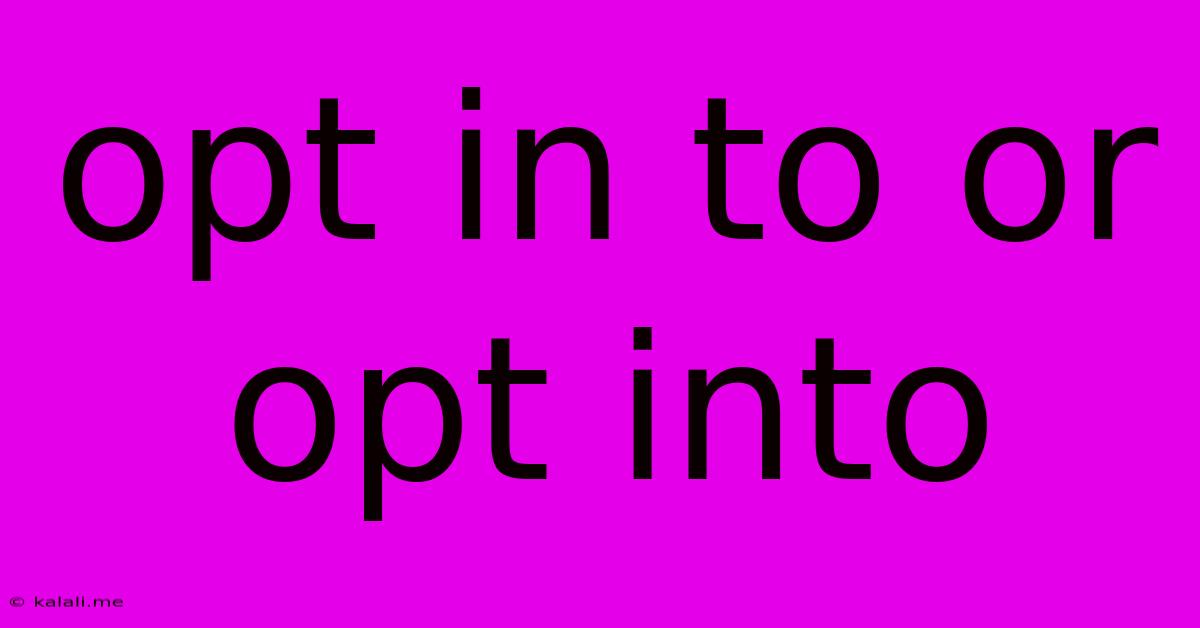Opt In To Or Opt Into
Kalali
May 24, 2025 · 2 min read

Table of Contents
Opt In To vs. Opt Into: Understanding the Nuances of Grammar
Choosing between "opt in to" and "opt into" can feel like navigating a grammatical minefield. While both phrases convey a similar meaning – agreeing to participate in something – there's a subtle difference that impacts clarity and grammatical correctness. This article will dissect the nuances of each phrase, helping you choose the right one for your writing. Understanding this seemingly minor detail can significantly improve the overall quality and professionalism of your writing.
What do "opt in to" and "opt into" mean?
Both phrases describe the action of choosing to participate in a program, service, or initiative, usually one requiring explicit consent. Think of email newsletters, subscription services, or loyalty programs. Essentially, it's a way of saying you're actively choosing to be included, rather than passively accepting.
The Grammatical Distinction: A Deeper Dive
The core difference lies in the preposition: "to" versus "into."
-
"Opt in to" implies choosing to participate in something. The preposition "to" indicates direction or purpose. It emphasizes the destination or the overall action of opting in. This is generally the more widely accepted and grammatically correct option.
-
"Opt into" implies choosing to become a part of something. The preposition "into" suggests movement or incorporation within a specific system or group. While grammatically permissible in certain contexts, it can sound slightly less formal and may appear less polished than "opt in to."
Examples to Illustrate the Difference:
Let's illustrate with examples to solidify the understanding:
-
Correct: "Please opt in to receive our weekly newsletter." (You are choosing to receive something directed towards you.)
-
Correct but less preferred: "Please opt into our loyalty program." (This is acceptable but "opt in to" would sound more natural and professional.)
-
Incorrect (generally): "I opted into agreeing to the terms." (This is clunky and wordy. A better approach: "I opted in to agree to the terms" or "I agreed to the terms.")
When to Use Each Phrase:
While "opt in to" is generally preferred for its clarity and formal tone, there are instances where "opt into" can work:
-
When the focus is on integration or becoming a part of a system: "They opted into the new software system." (This implies a complete integration within the software's functionality.)
-
In informal contexts: While not recommended for professional writing, "opt into" might sound more natural in conversational or informal settings.
Conclusion: Prioritize Clarity and Consistency
In most cases, "opt in to" is the preferred and more grammatically sound option. It offers greater clarity and presents a more polished and professional image. While "opt into" isn't grammatically wrong, it's less common and might sound slightly less refined in formal settings. Choosing the right preposition will enhance the overall quality of your writing and improve reader comprehension. Always strive for clarity and consistency in your grammar and style to ensure your writing is both effective and professional.
Latest Posts
Latest Posts
-
How To Separate Fan And Light Switch
May 25, 2025
-
Fallen Angels Names In The Bible
May 25, 2025
-
At The Bottom Or On The Bottom
May 25, 2025
-
How To Remove A Broken Screw From Wood
May 25, 2025
-
In Or On The Other Hand
May 25, 2025
Related Post
Thank you for visiting our website which covers about Opt In To Or Opt Into . We hope the information provided has been useful to you. Feel free to contact us if you have any questions or need further assistance. See you next time and don't miss to bookmark.